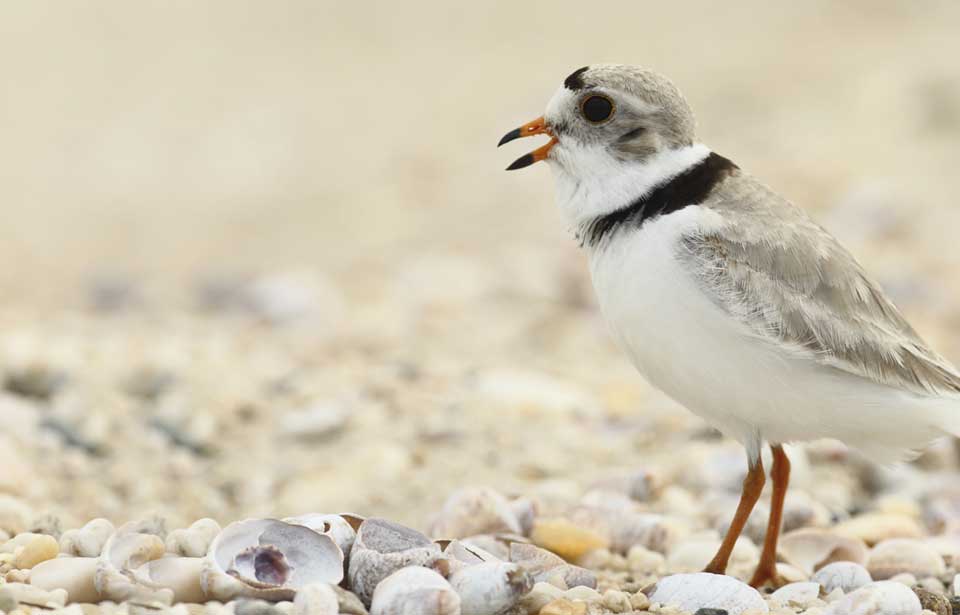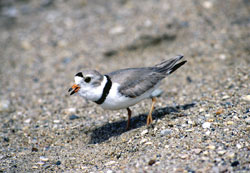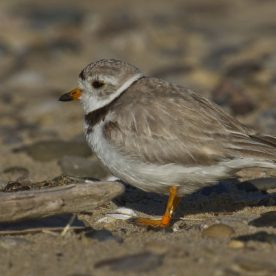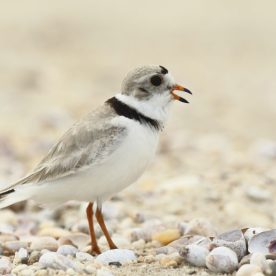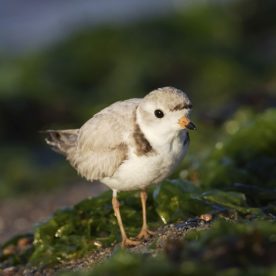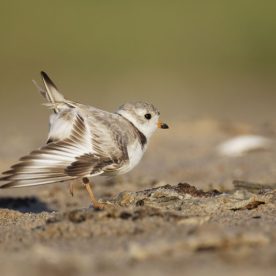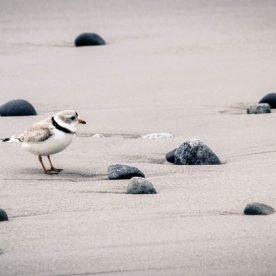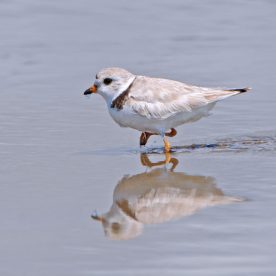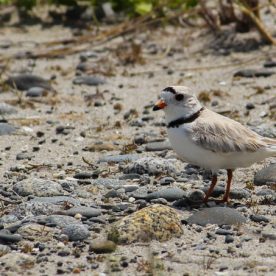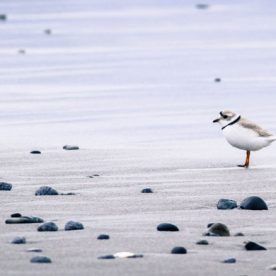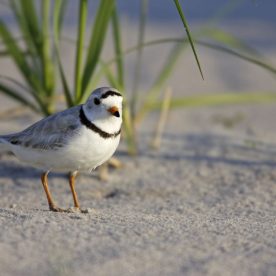Description
The Piping Plover Charadrius melodus is a small bird of lakeshores, river sandbars, and ocean coasts. With its head and back the colour of dried sand, the Piping Plover blends well into its beach surroundings, helping it hide from predators. It has a white rump, a partially black tail, a black band above its white forehead, and a single black “belt” or breastband (also referred to as a collar or neckband), which is sometimes incomplete, that contrasts with its white breast and abdomen. Its bright orange legs match its orange, black-tipped bill. Adults weigh from 43 to 64 g and are about the size of a bluebird.
Males and females are similar in appearance, although the males tend to have broader and more distinct black bands on the head and breast and a brighter orange bill. The adult winter plumage, which looks like the juvenile plumage, lacks the black head and breast bands. On the wintering grounds, orange legs distinguish the Piping Plover from other plover species.
The Piping Plover is the rarest of six “belted” plover species found in North America. The single band, or “belt,” of the Piping Plover tends to be more incomplete in coastal birds and complete in interior birds. The Piping Plover is often confused with the Semipalmated Plover Charadrius semipalmatus, which is similar in size to the Piping Plover but has a darker body, the colour of wet sand, lacks a white rump patch, and has more pronounced black bands on the forehead, cheek area, and neck. Taxonomically, the Piping Plover is split into two subspecies. The circumcinctus subspecies occurs in the Northern Great Plains and Great Lakes regions. The melodus subspecies is restricted to the Atlantic coast.
Signs and sounds
The Piping Plover’s call is a plaintive cry, sometimes described as a whistled peep-lo, with the first syllable higher. The male calls vigorously during its courtship flights and when preparing nest scrapes.
Habitat and Habits
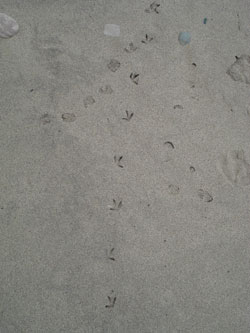
Photo: Diane Amirault-Langlais
Piping Plover tracks
Except in flight, this species is exclusively a beach bird, living its life within the confines of the water’s edge and the back vegetation line. The Piping Plover’s breeding habitat varies, influenced by water levels, plant growth, drought, precipitation, and ocean or lake storm surges. On the Atlantic coast, plovers nest above the normal high-water mark on sandy or gravel-sand beaches, particularly those overwashed by storms. On the prairies, most breed on gravel backshores of shallow saline lakes, and a few on sandy shores of larger prairie lakes. Others use river sandbars. Areas without vegetation and with good visibility are ideal for nesting; sometimes plovers nest in altered areas, such as parking lots or land that has been dredged. They raise their broods, or young, in similar spots, but they may use the entire width of the beach. Feeding habitats include the intertidal zone and sand, gravel, or mud flats near the water’s edge, as well as areas adjacent to the back vegetation of the beach and seeps or small pools on the beach. On the wintering grounds, plovers are found almost exclusively in marine environments on algal flats, sand beaches, and mud flats.
While Piping Plovers may live as long as 14 years, most probably survive fewer than five years.
Unique characteristics
Male Piping Plovers perform an amazing high-stepping goose step or “tattoo” march near the female just before mating.
Plovers walk with their feet turned inward, leaving a distinctive footprint on the beach that helps researchers and conservationists determine if plovers are present at a site.
Range
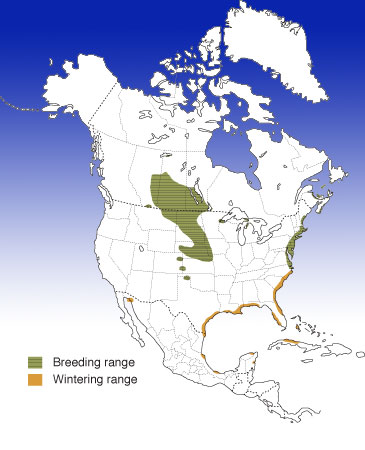
Distribution of the Piping Plover
The Piping Plover nests only in the United States and Canada, primarily in these three regions: along the Atlantic coast from the island of Newfoundland to South Carolina; in Michigan on the shores of Lake Michigan and in Wisconsin on the shores of Lake Superior; and throughout the Northern Great Plains, from the Prairie provinces to Colorado. Although individual birds are occasionally seen on the Canadian shores of the Great Lakes, Piping Plovers no longer regularly breed there. However, that trend may be changing. In 2007, Piping Plovers nested successfully on the Ontario shoreline of the Great Lakes for the first time in 30 years.
Plovers arrive on the breeding grounds from late March to May and spend only three to four months there before migrating in July and August to their winter haunts. Little is known about their migration behaviour. Great Lakes birds appear to make inland stops en route to Atlantic wintering areas, but Northern Great Plains birds are rarely seen on migration, suggesting they travel from breeding to wintering grounds in one flight. Eastern Canada plovers begin leaving their breeding grounds in early July and have been observed during migration at several locations along the New England states. This seems to suggest that they may make short stopovers en route to their wintering grounds.
Several studies have shown that most plovers return to the same wintering areas every year. Inland populations can be found wintering from July to April along the coast of the Gulf of Mexico from Florida to Mexico. Some Atlantic birds winter along the southern Atlantic seacoast of the United States, primarily from North Carolina to Florida. Plovers have also been sighted in Cuba, the Bahamas, and on some of the Caribbean islands. By late April, most plovers have left the southern climes for their northern breeding grounds.
Feeding
Piping Plovers feed on aquatic and terrestrial invertebrates, including marine worms, fly larvae, beetles, crustaceans, and molluscs, which they capture with their short bills by alternately running and pecking or probing along river, lake, and ocean shores. On the wintering grounds, Piping Plovers spend most of their days feeding along sand flats, mud flats, or beaches. Young Piping Plovers are precocial, learning to feed themselves while following and observing their parents. The amount of time they spend feeding tends to increase when temperatures decrease and tide levels subside.
Breeding
Soon after arriving on their Canadian breeding grounds from late March to May, male Piping Plovers begin flight and ground displays in their efforts to establish a territory and attract a mate. The plover’s classic aerial display involves a complex flight with slow exaggerated wingbeats accompanied by rapid persistent calling over feeding and nesting habitat. These flights may reach heights of 35 m and can continue for as long as half an hour. On the ground, males chase each other with their backs hunched and heads lowered, or run parallel to each other along invisible territory borders as they try to settle boundary disputes.
Territory size varies, ranging from 500 m2 (about the size of a basketball court) in eastern Canada to 51 000 m2 (the equivalent of 11 football fields) in the Prairies. Males call vigorously while scraping shallow depressions with their feet in sand or sand-gravel substrates. Females inspect the scrapes, perhaps for their suitability as a nest site, while males stand in or next to the depressions with partially outstretched wings and fanned tails. Small pebbles, seashell bits, or bone fragments are tossed toward the scrape and eventually form the lining of the nest.
Females are capable of nesting when they are one year old and may re-nest once or twice if their eggs are destroyed, but they normally rear only one brood each year. Piping Plovers usually keep the same mate during the breeding season, but may switch partners if a nest fails. Most plovers select new mates during the next nesting season.
Female Piping Plovers usually lay four pale buff-coloured, black-speckled eggs during early May. The eggs are laid on alternate days, and their pointed ends are oriented toward the centre within the sand or pebble-lined nest. Both sexes share incubation duties, which last from 26 to 28 days. When disturbed, Piping Plovers silently slip off their nests and run away from approaching intruders. To distract a potential predator, the plover may pretend to be injured as it leads the enemy away from its nest.
Most successful eggs hatch within four to eight hours of each other in June. The downy young leave the nest a few hours after drying off, and they never return to the nest itself. Chicks feed on their own, but are carefully guarded by both parents. During the first week or two and in poor weather, they seek refuge and warmth under the adults. When danger arises, young plovers freeze in a crouched position, making them difficult to locate among the sand and gravel. Young plovers can make short flights at about 20 to 25 days of age and are able to maintain flight by 27 days of age. The male parent appears to take the majority of the responsibility for chick care. The female sometimes abandons the family, leaving the male to care for the young until the family disperses.
The breeding population of Piping Plovers can vary from one year to another depending on various factors, including habitat availability. A 2001 census of the North American population reported that there were about 1 454 adults in Canada, with 481 in the Atlantic population, 972 in the prairie population, and one bird in the Great Lakes region.
Conservation
Although international censuses show that the total population count for Piping Plovers has increased by about 8 percent since 1991, regional declines have occurred. Populations have grown in the U.S. Great Lakes region and along the U.S. Atlantic coast, likely thanks to intensive management of this species (placing protective barriers to safeguard nests, public education programs, predator management, and enforcement of off-road vehicle legislation). The Northern Great Plains population of Piping Plovers has declined by 15 percent since 1991; conversely, the overall Atlantic coast population has increased by 77 percent. Recent census data, however, suggest that the Northern Great Plains population is increasing.
The Piping Plover has been assessed as an endangered species by the Committee on the Status of Endangered Wildlife in Canada and is listed under the Species at Risk Act. Most Canadian provinces where the species occurs have also listed the species as endangered. In the United States, the Great Lakes population is listed as endangered and the Northern Great Plains and Atlantic Coast populations are listed as threatened under the Endangered Species Act. The species is also identified as near threatened on the 2006 Red List of Threatened Species maintained by the World Conservation Union’s (IUCN) Species Survival Commission.
Several factors may be involved in the regional declines, including human disturbance, loss of habitat, and predation. A study examining Piping Plover reproduction on the Canadian prairies and the American Great Plains suggests that the plover may not be producing enough young to maintain a stable population. In Atlantic Canada, recent research has indicated that a very small number of young birds return to nest, despite having successfully left the breeding grounds the previous year to migrate south. This suggests that threats during migration and wintering may be affecting Piping Plovers. On the plover’s wintering grounds in the southern United States, off-road vehicle use and urban and industrial development threaten beaches where plovers feed.
All along the Atlantic coast, predation and human recreational activities are contributing to nesting losses. All-terrain vehicle users, swimmers, and beachcombers disturb Piping Plovers and may damage their nests and eggs and interrupt foraging of plover chicks. Studies show that fewer young are raised on beaches that are popular for recreation than on less-disturbed beaches. In fact, a heavily used beach may be abandoned by nesting birds. Development is also a factor, as many traditional coastal habitats are being developed, and dams contribute to a loss of nesting and brood-rearing habitat, particularly in high-water years. Climate change may be a threat too: more frequent droughts on the prairies and flooding on the Atlantic coast may reduce the plover’s habitat.
Piping Plovers are threatened by both birds and mammals. Gulls, crows, raccoons, foxes, minks, weasels, and skunks may eat plover eggs, and falcons may prey on the adults or young. Threats to the circumcinctus subspecies on the Canadian Prairies also include cattle trampling of nesting and brood-rearing habitat when the cattle make their way to the water’s edge for a drink.
Both Environment Canada and the United States Fish and Wildlife Service, in cooperation with provinces, states, and other agencies, have developed recovery techniques aimed at maintaining or increasing plover numbers. Various conservation measures, such as signs, patrols, exclosures to keep predators out, captive releases, the relocation of eggs, surveys, and public education by non-government organizations, provincial wildlife agencies, Parks Canada, and the Canadian Wildlife Service have helped to protect the plover. Hope exists that adults from the increasing U.S. Great Lakes population will reoccupy the Canadian Great Lakes region in greater numbers, as the first nesting of plovers in 30 years occurred in that region during 2007. Research by government and university biologists has aided in the understanding of the plover’s biology and its population. This knowledge, combined with the help of wise land management by landowners and conservation actions by the general public, will help ease the plover’s plight.
If you live near or visit a beach where Piping Plovers nest, you can help the plover by not disturbing adults, their nests, or broods, as well as by asking other people to do the same. Keeping your pet dog or cat off beaches where Piping Plovers nest will also help reduce disturbance of and predation on the birds. You can also combat inadequate disposal of garbage. This helps the plovers indirectly because crows, foxes, and gulls that could eat Piping Plover eggs are increasing in numbers largely because of the extra food that humans make available.
Newfoundland and Labrador, Nova Scotia, Prince Edward Island, New Brunswick, Quebec, Manitoba, Saskatchewan, and Alberta have volunteer guardianship programs that protect eggs and chicks and help to inform the public about the plover.
No matter where you live, you can contribute to the conservation of the Piping Plover and its habitat by supporting conservation organizations and informing others about what you have learned.
Resources
Online resources
Canadian Wildlife Federation, Be a Piping Plover Guardian
Canadian Wildlife Federation, Wildlife Magazine, Satus: All Hands On Deck
Species at Risk Registry, Piping Plover circumcinctus subspecies
Species at Risk Registry, Piping Plover melodus subspecies
U.S. Fish and Wildlife Service, Piping Plover
All About Birds, Piping Plover
Audubon Field Guide, Piping Plover
Print resources
Amirault, D.L. (editor). 2005. The 2001 international Piping Plover census in Canada. Technical Report series no. 436. Canadian Wildlife Service, Environment Canada, Sackville, New Brunswick.
Boyne, A.W. In press. Update COSEWIC status report on the Piping Plover circumcinctus subspecies (charadrius melodus circumcinctus) and the melodus subspecies (Charadrius melodus melodus) in Canada in COSEWIC assessment and update status report on the Piping Plover circumcinctus subspecies (charadrius melodus circumcinctus) and the melodus subspecies (Charadrius melodus melodus) in Canada. Ottawa.
Environment Canada. 2006. Recovery strategy for the Piping Plover (Charadrius melodus circumcinctus) in Canada. Species at Risk Act Recovery Strategy Series. Environment Canada, Ottawa. (Also available online at www.sararegistry.gc.ca)
Goossen, J.P., and D.L. Amirault (editors). 2004. The 1996 international Piping Plover census in Canada. Technical Report series no. 416. Canadian Wildlife Service, Edmonton, Alberta, and Sackville, New Brunswick.
Goossen, J.P., D.L. Amirault, J. Arndt, R. Bjorge, S. Boates, J. Brazil, S. Brechtel, R. Chiasson, G.N. Corbett, R. Curley, M. Elderkin, S.P. Flemming, W. Harris, L. Heyens, D Hjertaas, M. Huot, B. Johnson, R. Jones, W. Koonz, P. Laporte, D. McAskill, R.I.G. Morrison, S. Richard, F. Shaffer, C. Stewart, L. Swanson and E. Wiltse. 2002. National Recovery Plan for the Piping Plover (Charadrius melodus). National Recovery Plan No. 22. Recovery of Nationally Endangered Wildlife. Ottawa.
Haig, S.M. , C.L. Ferland, F.J. Cuthbert, J. Dingledine, J.P. Goossen, A. Hecht, and N. McPhillips. 2005. A complete species census and evidence for regional declines in Piping Plovers. Journal of Wildlife Management 69: 160–173.
© Her Majesty the Queen in Right of Canada, represented by the Minister of the Environment, 1989, 1995, 2007. All rights reserved.
Print version
Catalogue number CW69-4/78-2006E
ISBN 0-662-44561-9
Online in HTML and PDF at www.hww.ca.
PDF version
Catalgue number CW69-4/78-2006E-PDF
ISBN 978-0-662-47097-7
Text: J. Paul Goossen
Revision: J. Paul Goossen, 1995; J. Paul Goossen and D. Amirault-Langlais, 2007.



